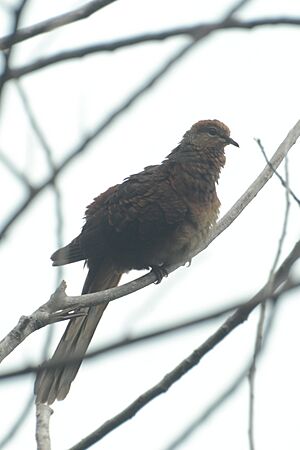Amboyna cuckoo-dove facts for kids
Quick facts for kids Amboyna cuckoo-dove |
|
|---|---|
 |
|
| Conservation status | |
| Scientific classification | |
| Genus: |
Macropygia
|
| Species: |
amboinensis
|
| Subspecies | |
|
See text |
|
| Synonyms | |
|
Columba amboinensis Linnaeus, 1766 |
|
The Amboyna cuckoo-dove (Macropygia amboinensis) is a type of dove. You can find it in the Moluccas and New Guinea. It belongs to a group of doves called Macropygia.
Scientists recently decided this bird was a unique species. Before 2016, it was thought to be the same as the slender-billed cuckoo-dove.
Contents
About Its Name
The Amboyna cuckoo-dove got its scientific name, Columba amboinensis, from Carl Linnaeus in 1766. He was a famous Swedish scientist. The name "amboinensis" comes from Ambon Island, where the first bird was found.
Later, scientists moved this dove into a different group called Macropygia. This group was created by an English scientist named William John Swainson in 1837.
Scientists sometimes change how they classify animals. In 2016, they realized the Amboyna cuckoo-dove was different from the sultan's cuckoo-dove. They made this decision after studying the birds' calls.
Different Types of Amboyna Cuckoo-Doves
There are nine known types, or subspecies, of the Amboyna cuckoo-dove. These different types live on various islands. They are found across the Moluccas, Admiralty Island, the Bismarck Archipelago, and other islands in the region.
- M. a. amboinensis - Found in the central Moluccas, like Buru and Seram Island.
- M. a. admiralitatis - Lives on Admiralty Island.
- M. a. carteretia - Found in the Bismarck Archipelago.
- M. a. keyensis - Lives in the Kai Islands.
- M. a. maforensis - Found on Numfor Island.
- M. a. griseinucha - Lives on Mios Num.
- M. a. meeki - Found on Manam Island.
- M. a. cinereiceps - Lives in the D'Entrecasteaux Islands.
- M. a. cunctata - Found in the Louisiade Archipelago.
What It Looks Like
The Amboyna cuckoo-dove is usually about 35 to 37 centimeters (14 to 15 inches) long. Male doves often have a pretty rose or green color on their neck.
In some areas, like Indonesia and Papua New Guinea, many of these doves have lighter feathers on their undersides. They might also have fine dark stripes or a whitish cap on their heads.
Its Call
The call of this dove is quite loud. It sounds like a "whoop-a whoop." The exact sound can be a little different depending on which subspecies it is.
Where It Lives
The Amboyna cuckoo-dove likes to live in different kinds of places. You can find it in rainforests, woodlands, and areas with thick bushes called scrubland. It also lives in places where rainforests are growing back after being cut down.
How It Behaves
You can often see these doves in pairs or in small groups. They like to eat berries. They eat berries from plants that naturally grow there, and also from some weed species that have been introduced.
These doves might move around a lot. They do this to find enough food. They are strong flyers but usually fly short distances. They also tend to fly low to the ground.
Breeding and Nests
Amboyna cuckoo-doves usually have their babies in the spring and summer. Their nest is quite simple. It's a flat platform made of sticks and vines. They build it either in the fork of a tree or on top of a low tree. The female dove lays one creamy white egg.


